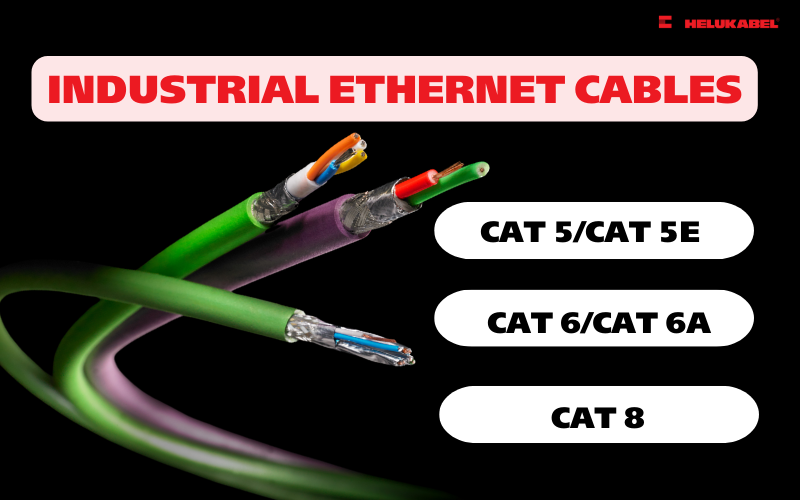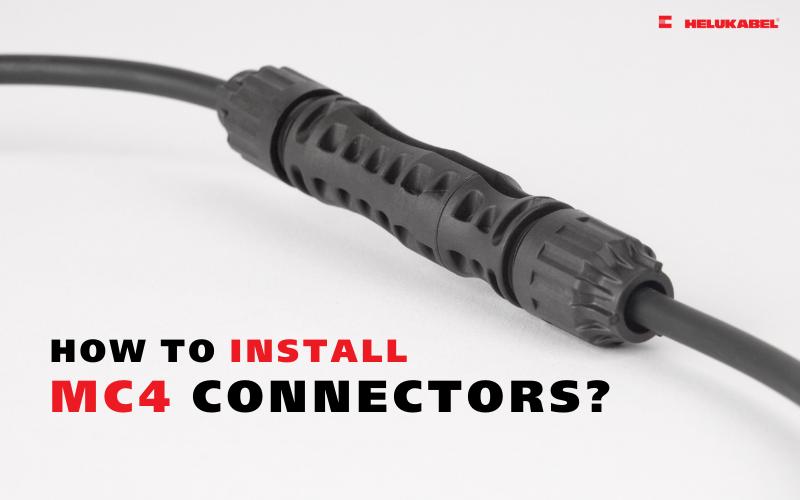Common types of RJ45 connectors and their applications
The RJ45 connectors enable connections with Ethernet cables, ensuring a stable and reliable network connection in most industrial, commercial, and residential applications.
1. What are RJ45 connectors
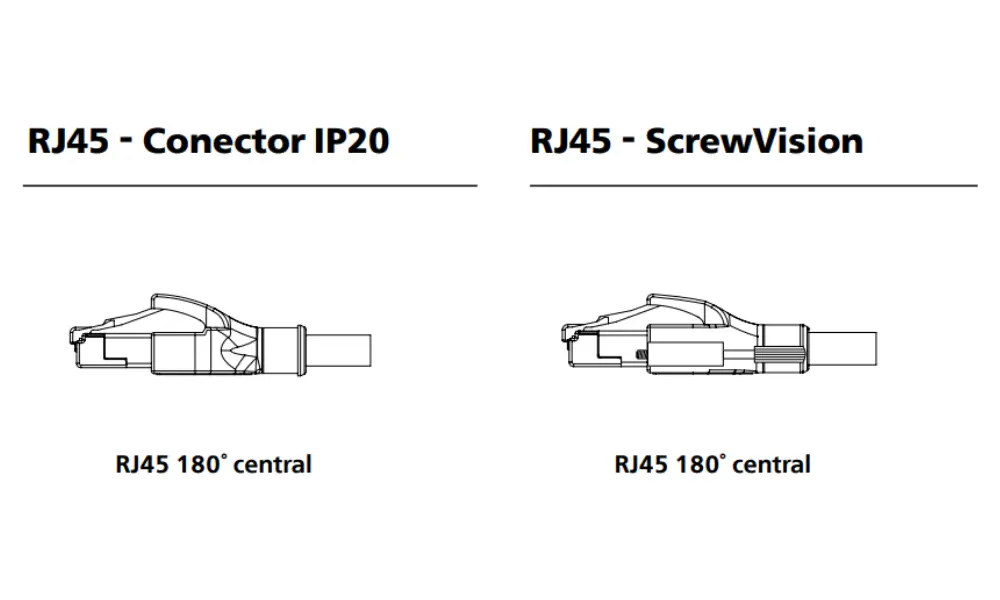
"RJ" stands for Registered Jack, a telecommunications connection standard that facilitates the linking of data and voice transmission devices. This standard was first defined by the Bell System, and in the 1970s, the Federal Communications Commission (FCC) authorized its use to ensure customer equipment compatibility with telecommunications service providers' systems. The number "45" refers to the designation of this connection standard within the networking standards catalog.
There are various types of modular jacks used in telephone and networking systems, with RJ45 being one of the most common connectors in Ethernet networks. However, the term "RJ45 connector" is not entirely accurate. The correct name is 8P8C (8 Positions, 8 Contacts) connector, which means it has 8 positions and 8 electrical contacts. This type of connector is typically attached to the ends of Ethernet cables. A complete network cable (Ethernet cable) usually consists of an Ethernet cable with RJ45 connectors on both ends.
>>See more: What are cable connectors? Why are they used?
2. Components of RJ45 connectors
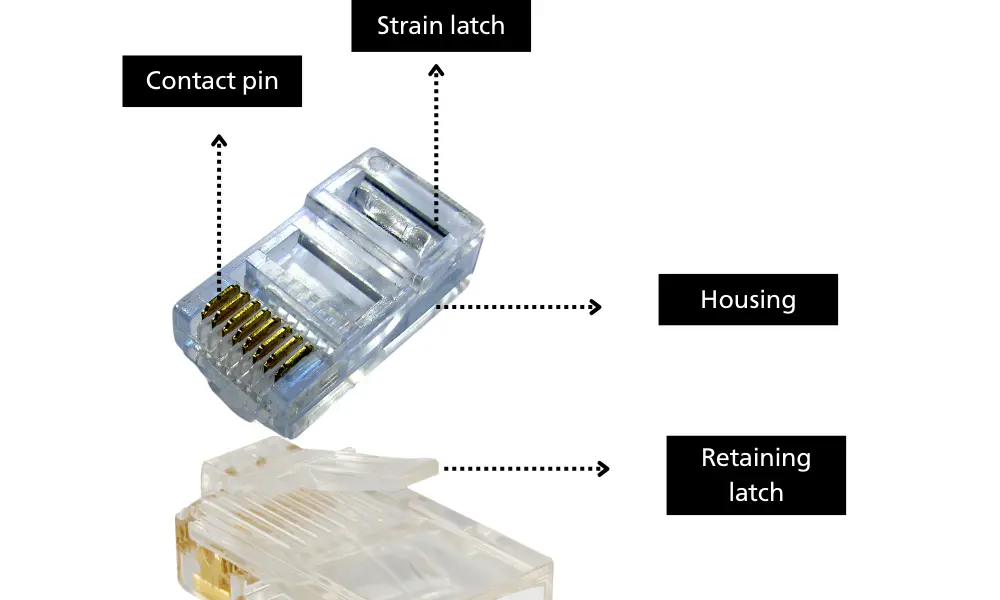
The RJ45 connectors consist of several important components:
- Plastic housing: The RJ45 network connector typically has a plastic housing made from high-performance PC material. The more transparent the housing, the higher the material quality.
- 8 contact pins: Not all RJ45 connectors on the market have gold-plated contact pins. However, gold-plated pins provide better resistance to corrosion and oxidation, ensuring more stable signal transmission. There are two types of gold-plated contact pins: Two-prong type: Suitable for stranded cables. Three-prong type: Compatible with both solid and stranded cables, offering a more secure connection and ensuring a stable link.
- Strain latch and retaining latch: The strain latch helps secure the RJ45 connectors into the network port, preventing it from becoming loose during use. Most Ethernet connectors have a strain latch along with a small rectangular hole, so a specialized crimping tool is required for proper termination. The retaining latch holds the network cable in place, preventing it from slipping out of the connector. When inserting or removing the RJ45 connector, press this latch gently to make installation and removal easier.
3. T568A and T568B wiring standards for RJ45 connectors
3.1 What are the T568A and T568B standards?
The RJ45 connector plays a crucial role in networking systems, enabling Ethernet cables to connect to devices such as routers, switches, and computers. Understanding the wire color codes and pinout diagrams of RJ45 connectors is essential for ensuring a stable and reliable network connection.
When wiring an RJ45 connector to an Ethernet cable, you need to consider two possible wiring standards: T568A and T568B, depending on your chosen wiring scheme:
- Each RJ45 connector has 8 positions (8P8C), meaning it requires 8 conductor wires to transmit data.
- These conductors are typically twisted into 4 twisted pairs to reduce interference and enhance signal transmission performance.
- The four primary colors used in both the T568A and T568B standards are: green, orange, blue, and brown.
Although the wire arrangements differ between the two standards, both ensure a stable network connection when used correctly.
>>See more: A glance at ethernet cables - Common types of ethernet cables

T568A wiring standard
3.2 T568A wiring standard for RJ45 connectors
The T568A wiring standard is commonly used in residential networking systems and is recommended by the U.S. government as the preferred wiring scheme. Below is the pinout order for the T568A standard when terminating an RJ45 network cable:
- White/Green
- Green
- White/Orange
- Blue
- White/Blue
- Orange
- White/Brown
- Brown

T568B wiring standard for RJ45 connectors
3.3 T568B wiring standard for RJ45 connectors
The T568B wiring standard is more widely used in business and commercial networking systems. It is the most commonly adopted standard worldwide, especially in Ethernet networks.
Below is the pinout order for the T568B standard when wiring an RJ45 network cable:
- White/Orange
- Orange
- White/Green
- Blue
- White/Blue
- Green
- White/Brown
- Brown
Due to its widespread usage, the T568B standard is often preferred in most networking systems, ensuring compatibility and easier integration with various network devices.
4. Types of RJ45 connectors

There are several ways to classify RJ45 connectors, such as by cable type, design, and application. Below are some of the most common classifications:
4.1 Male RJ45 connectors vs. female RJ45 connectors
The male RJ45 connector is the plug found at both ends of an Ethernet cable. It is typically made of transparent, white, black, or gray plastic, though different colors and materials may be available. Male RJ45 connectors are crimped onto network cables and are used to connect to female RJ45 ports on routers, switches, computers, and other networking devices.
The female RJ45 connector is the recessed socket designed to accept the male RJ45 plug. It is also known as an RJ45 female jack or RJ45 female socket. On most TVs, PCs, and other electronic devices, the RJ45 female port is located on the I/O (input/output) panel, often alongside other connectors such as HDMI and USB.
4.2 Standard RJ45 vs. Pass-Through RJ45 connectors
Standard RJ45 connectors (Non-Pass-Through RJ45): Also known as the traditional 8P8C connectors. In this type, the network cable wires do not pass through the plug but are instead secured inside before crimping. A specialized RJ45 crimping tool is required to attach the wires to the connector.
Pass-Through RJ45 connectors: This type allows the cable wires to extend through the connector, making it easier to align them before crimping. Its main advantage is that it simplifies the wiring process and reduces errors in wire arrangement.
4.3 Shielded vs. unshielded RJ45 connectors
Unshielded RJ45 connectors: These connectors have plastic housing and are typically used with Unshielded Twisted Pair (UTP) cables. They are ideal for environments with minimal electromagnetic interference (EMI), such as homes and offices.
Shielded RJ45 connectors: These connectors feature a metal shield around the housing to protect against EMI. They are used with Shielded Twisted Pair (STP) cables and are commonly found in factories, data centers, and industrial environments with high levels of electronic interference.
Important note: Do not use shielded RJ45 connectors with unshielded cables, as this may negatively impact network performance. Always choose the appropriate connector type based on your cable to ensure optimal network efficiency.
5. Applications of RJ45 connectors

Thanks to their versatile design, RJ45 connectors are widely used across various fields:
- Home networking: In residential areas, RJ45 connectors play a crucial role in setting up wired connections for home networks. They ensure fast and stable data transmission between devices such as computers, TVs, and gaming consoles.
- Building automation: RJ45 connectors are commonly used in controllers and sensors within buildings to manage and connect systems such as ventilation, air conditioning, and access control. Their stable connection ensures efficient data transmission in commercial buildings.
- Data centers: In the complex infrastructure of data centers, RJ45 connectors are essential for linking servers, switches, and other network components. Their standardized configuration enables seamless integration, contributing to the overall performance and reliability of data center operations.
- Industrial applications: RJ45 connectors provide secure connections for machinery, control systems, and automation devices. Their durability and reliability make them an ideal choice for harsh industrial environments.
- Telecommunications: RJ45 connectors are frequently used in the telecommunications industry to connect network devices, routers, and switches. Their widespread use and compatibility make them a key component in telecommunications networks, facilitating seamless data and voice transmission.
6. RJ45 Connectors - Products and solutions from HELUKABEL

As digitalization and automation continue to evolve, stable and reliable network connectivity plays a crucial role in most industrial, commercial, and residential applications. HELUKABEL offers a comprehensive range of RJ45 solutions, including RJ45 connectors, RJ45 cables, and crimping tools, ensuring optimal performance, durability, and flexible connectivity under all working conditions.
6.1 RJ45 connectors
HELUKABEL provides a wide variety of RJ45 connectors with multiple design options, compatible with industry standards such as PROFINET, TIA 568A, and TIA 568B:
- Design variants: Available in straight connectors, angled connectors (45°, 90°, 180°), and Push-Pull connectors.
- Water and dust protection standards: IP20, IP67.
- Number of contact pins: Options include 4-pin or 8-pin connectors, depending on the networking standard.
- Compatibility with core diameters (Ø) from 1.0 mm to 1.6 mm and overall cable diameters (Ø) from 4.5 mm to 10.0 mm.
6.2 RJ45 cables
HELUKABEL offers a wide range of Ethernet cables compatible with RJ45 connectors, including:
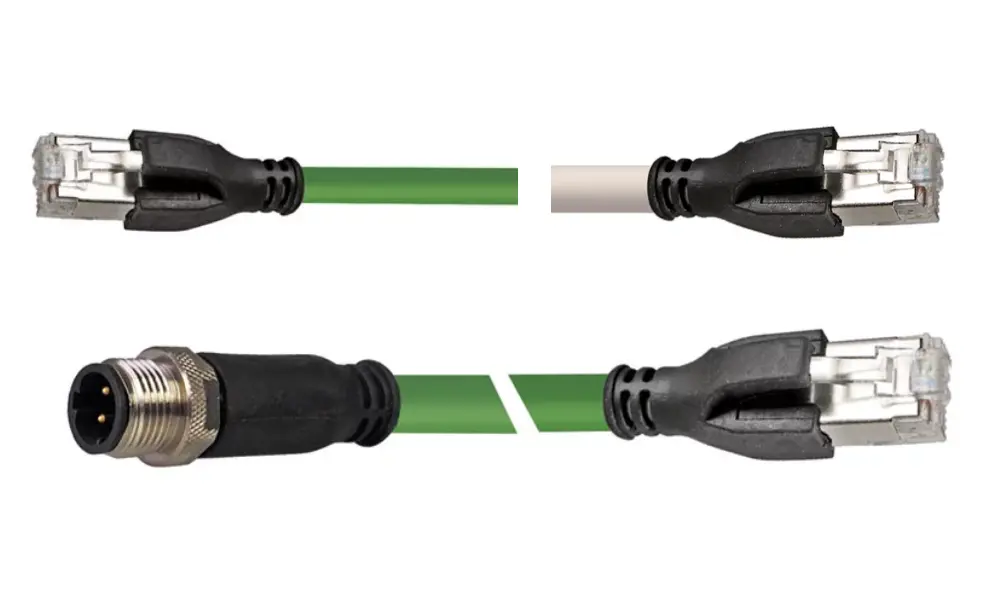
6.3 Patch cables
In addition to Ethernet cables, HELUKABEL also provides pre-assembled RJ45 patch cords. These patch cords ensure fast, easy, and reliable connections without the need for manual assembly:
- Patch Cables PROFInet A
- Patch Cables PROFInet B
- Patch Cables PROFInet C (PUR) (806409)
- Patch Cables PROFInet C (PVC)
In addition to standard RJ45 patch cords, HELUKABEL also offers hybrid patch cords featuring RJ45 connectors on one end and M12 D-coded connectors on the other.
If you still have any concerns or questions, don't hesitate to reach out to HELUKABEL Vietnam's engineering team promptly for detailed assistance.
HELUKABEL® Vietnam
| Address | 905, Nguyen Kiem Street, Ward 3, Go Vap District, Ho Chi Minh City 700000, Vietnam |
| info@helukabel.com.vn | |
| Hotline | +84 28 77755578 |
| Website | www.helukabel.com.vn |
| Discover our products and place orders | Tiki | Shopee | Lazada | Product finder |
| Follow us on | Facebook | LinkedIn | Instagram | Youtube | Zalo | WhatsApp | Tiktok | Spotify |

